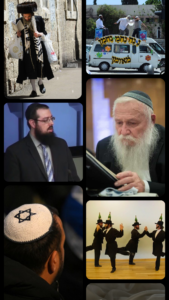
THE ASHKENAZIM
Although I want to focus more on contemporary history, it’s good to start by saying that between the 11th and 15th centuries, major rabbinic schools (yeshivot) developed in the area of Spain (known today as Sepharad) and the Eastern European region (known as Ashkenaz). Although the former is older of the two, which I will address separately in another writing, Ashkenazi identity and definition became very clear, with their own language (Yiddish: Judeo-German), religious traditions and rituals (minhagim), and even a distinctive culinary art.
I take this opportunity to clarify that recent DNA studies connect this group with various communities in the Mesopotamian East, which dismisses the theory that this group descends exclusively from the Indo-European people known as the Khazars (whose history of conversion to Judaism has fascinated several writers and especially theorists of antisemitic conspiracies, although this is far from historically demonstrable).
These Ashkenazi schools expanded over time to areas such as Poland, Russia, Lithuania, Austria, Hungary, and others in the same region. As a consequence of the global impact of the Renaissance and to some extent the Lutheran Reformation on the Ashkenazi world, a reformist movement also emerged among them, aiming to update many of the customs that had marked this diaspora until then, focusing uniquely or giving singular importance to social ethics. For them, the authority of Scripture was not so much divine as it was of the people of Israel themselves, so if this was more the word of the people than of God, they could distinguish between cultural customs of Israel and its ethical social values.
As a reaction to this reformist movement, another movement emerged that sought to preserve everything as it had been received up to that point, including that new Ashkenazi culture that had developed from the dynamics between Judaism and European culture, and this was called Orthodox. Both movements grew and began to decide the daily life of Jews throughout the Ashkenazi world.
Once emigration to the USA began as a result of persecutions (as narrated in the famous movie “Fiddler on the Roof”), another group emerged in the new diaspora that did not want to live so separated from Judeo-European customs, but also did not want to live in Orthodox extremism since they were in other lands, and they called themselves Conservatives (Masorti).
Now, within the Orthodox movement specifically, another interesting phenomenon occurred, and that is that many different groups emerged within it without abandoning rabbinic orthodoxy: Modern Orthodox Jews, for example, wear a knitted kippah (head covering) that can be of various colors and live a socially modern life (jobs, studies, political life, etc.). However, there were also Haredi or ultra-Orthodox Jews who are more exclusivist and try to distance themselves completely from anything that might have a “gentile” influence, although they are unable to distinguish that most of their customs are from the gentiles and from the medieval era of their Eastern Europe. These are distinguished from Modern Orthodox Jews by their clothing, which consists solely of black and white, with a black kippah and fox fur hats.
These Haredi Jews are further divided into two general groups: those coming from the Lithuanian school and the Hasidic Jews. These two are very similar, and their differences are very subtle details (for example, Lithuanians place their sidelocks (peyot) behind their ears and can shave their beards, while Hasidic Jews leave their sidelocks longer in front of their ears and cannot shave). If we take a magnifying glass and look within these two Haredi groups, we will see that within each one there are also others, such as within Hasidism where we find groups like Chabad Lubavitch, Satmar, Bovod, Pupa, Breslov, Karliner, etc.
So, when we hear about all these names today: reformists, conservatives, Orthodox, Hasidic, reconstructionists, and whatever names we can’t imagine, all of this happens only within the community that comes from the Ashkenazi diaspora. Other diasporas are considered Orthodox by them, but those groups would never call or classify themselves as such; they simply call themselves Sephardic, Mizrahi, Romaniote, and Greek, among whom such fragmentation has never existed.
To be continued…
Author: Dr. Liber Aguiar
0 Comments